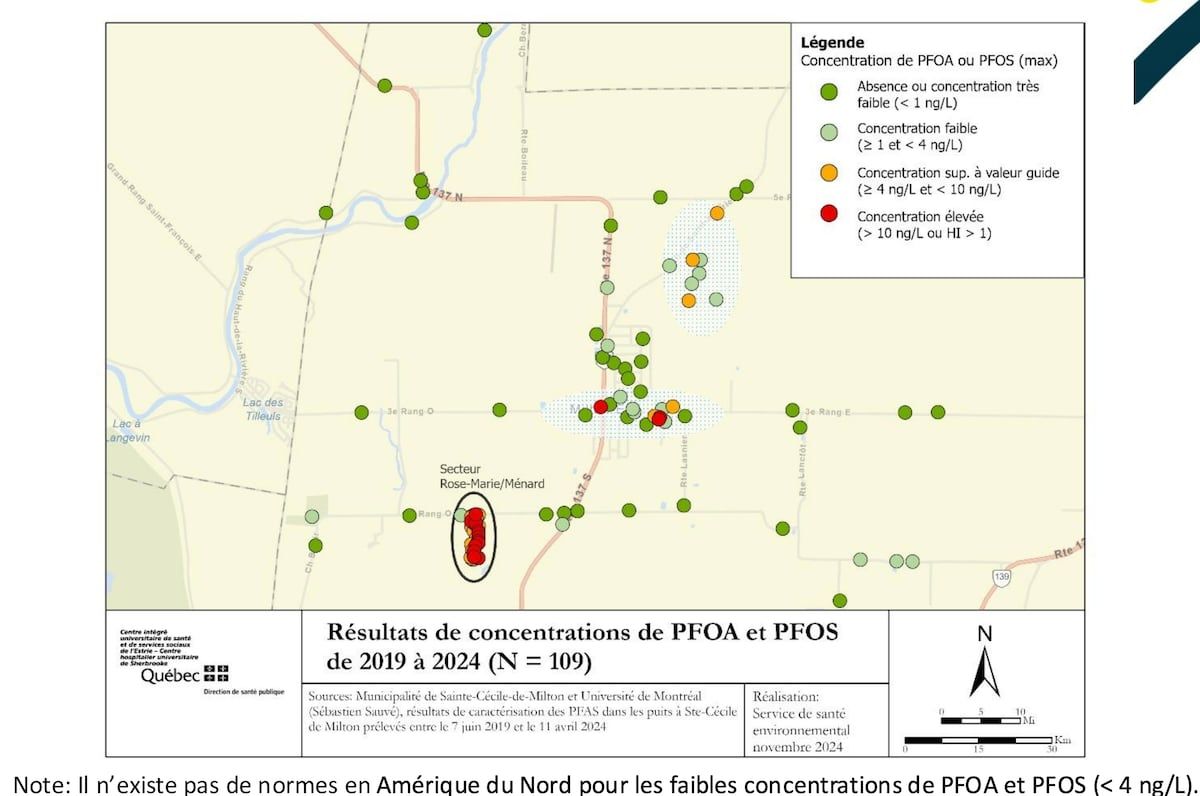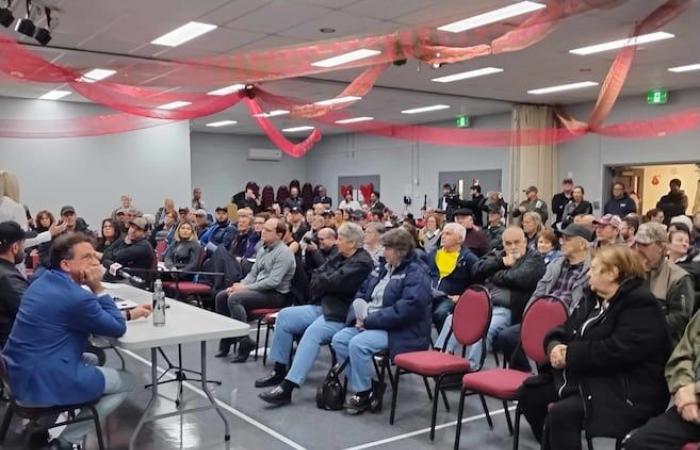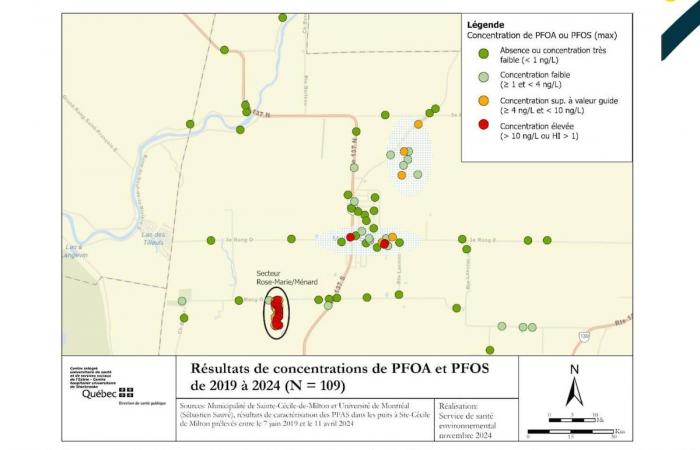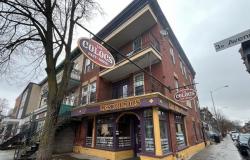Several gray areas still surround the mysterious “emerging contaminants” that are PFAS (or perfluorinated) in Sainte-Cécile.
This type of contaminant is found elsewhere in Quebec, mainly in La Baie, Val d’or, Saint-Donat or L’Épiphanie.
But no other city than Sainte-Cécile-de-Milton is the subject of as many tests and studies, thanks in particular to the desire of its mayor to clarify the mystery.
Doctor Mélissa Généreux, medical advisor to the Public Health Department of the CIUSSS de l’Estrie – CHUS (Jérôme Savary/La Voix de l’Est)
The meeting on Wednesday evening was very popular with citizens, with more than 200 of them — by the looks of it — having responded.
The objective was above all to present the results of 88 new water tests carried out in different sectors of the Municipality last April.
A confirmation: the problematic landfill
Residents of the Rose-Marie and Ménard streets sector have had confirmation of what was predicted by the worrying preliminary tests carried out between March 2023 and January 2024.
This sector of the City has 35 addresses, and as many wells.
The City has around 1000 addresses in total and the same number of wells.
The results of the 25 additional tests carried out in the Rose-Marie/Ménard district reveal levels of PFOA and PFOS — two contaminants from the PFAS family whose effects on health are best documented — exceeding 10 ng/L (nanograms per liter of water), while the standard in the United States is 4 ng/L.
There is no such government standard in Canada for these two specific contaminants.
This sector of the Municipality is located very close to the landfill site operated by the company Matrec.
The Ministry of the Environment establishes a clear relationship between water released from the landfill and PFAS contamination in the surrounding area.
The three speakers of the evening assured this “beyond any doubt”.
Both Doctor Mélissa Généreux, medical consultant at the Public Health Department of the CIUSSS de l’Estrie – CHUS, Sébastien Sauvé, professor of environmental chemistry and specialist in PFAS, and the mayor of Sainte-Cécile, Paul Sarrazin, indicated that the Ministry of the Environment had reached this conclusion.
Lawyer Brian Furlong challenged Mayor Sarrazin and pointed the finger at Matrec, arguing that the company should, in his opinion, take responsibility for solving the drinking water problem in this sector of the City.
L’avocat Brian Furlong (Jérôme Savary/La Voix de l’Est)
Please note that Mr. Furlong is defending the plaintiffs in a class action suit against the company managing the landfill site.
Mr. Sarrazin had previously indicated that he was instead looking for a solution with the government – he said he was in contact with the Ministry of Municipal Affairs and Housing – to help residents of this sector of the Municipality.
The main health effects and solutions
According to Estrie Public Health, “the most likely effects of exposure for a few months to a few years to PFAS are”:
- A poorer immune response to vaccines
- An imbalance of lipids in the blood (including cholesterol)
- An increased risk of kidney cancer
- Low birth weight
For the Rose-Marie/Ménard sector, residents are therefore recommended not to consume water from their wells, unless their residence is equipped with a reverse osmosis system (CSA-B483.1 standard or NSF 58), given as an example by Professor Sauvé.
The professor of environmental chemistry and his team carried out these tests and analyzed them.
Otherwise, Mr. Sauvé recommends using a filter pitcher (NSF standard 53). Standards are important, with some pitcher brands — including the most well-known — being ineffective at treating PFOA and PFOS.
A results map
During the evening, Dr. Généreux presented a map listing all the results of the 109 tests carried out at Sainte-Cécile, between 2019 and 2024.

The map listing the results of the 109 tests carried out in Sainte-Cécile, between 2019 and 2024 (CIUSSS of Austria-CHUS)
Of the 88 water tests carried out last April, 63 concerned sectors other than that of Rose-Marie/Ménard.
Nearly 40 of these tests will reassure their owners. Represented by the dark green dots on the map, they reveal an absence or a very low concentration of contaminants, making their well water completely drinkable.
All owners of tested residences will be notified of their results by mail.
Two other problematic sectors, including school
Elsewhere in the territory of the municipality of nearly 2,300 inhabitants, two other sectors — rue Principale and rue des Bouleaux — present PFOA and PFOS levels greater than 4 ng/L, this standard establishing a maximum not to be exceeded at UNITED STATES.

Paul Sarrazin, mayor of Sainte-Cécile, surrounded by Professor Sébastien Sauvé and Mélissa Généreux, doctor of public health (Jérôme Savary/La Voix de l’Est)
Sainte-Cécile school confirms high levels of PFOA (more than 6 ng/L) and PFOS (more than 8 ng/L), levels already encountered in October 2023.
Whether it is the school or other problem sites, the source of the contamination is unknown.
For owners who have obtained such results, the Estrie Public Health Department (DSP) recommends that an “alternative water source should be used for drinking, preparing drinks such as juice, tea, coffee, milk for baby and prepare water-based foods (e.g. soup, broth)”.
Gray areas
The points appearing in pale green on the map have contaminant levels between 1 and 4 ng/L.
The DSP recommends in this case to “use well water normally,” adding: “You may, however, want to reduce your exposure to these contaminants by opting for an alternative source of water for drinking.”
“These results are located in an area of scientific uncertainty, with possible health risks, but nothing strong enough at the scientific level as a level of proof for us to be able to issue a formal recommendation,” specifies Dr. Généreux, in interview with The Voice of the Eastearlier Wednesday afternoon.
In all of our blood
Professor Sauvé and his team of students carried out PFAS testing in nearly 350 municipalities from 2018 to 2020.
According to the professor, approximately half of Quebecers have PFOA and PFOS levels between 1 and 4 ng/L.
“There are surely more PFAS in Montreal than elsewhere [que le secteur Rose-Marie/Ménard] at Sainte-Cécile,” he further illustrated, during his very well-popularized presentation.
“We all have too much PFAS in our blood.”
— Sébastien Sauvé, professor of environmental chemistry at the University of Montreal
Sainte-Cécile may have undergone a hundred tests, but only 10% of its wells have been tested.
Part of the mystery of PFAS therefore remains unsolved.
On your couch
Remember that “PFAS [étaient] exploited since the 1940s due to their flame retardant, stain resistant, non-stick, emulsifying and waterproofing properties. Consequently, many consumer products contain it,” we can read on the website of the National Institute of Public Health of Quebec (INSPQ).
If PFAS are found in the foams used by firefighters to put out fires, we also find them closer to us, image M. Sauvé.
As much on sofa or chair covering fabrics, as in cosmetics, or on water-resistant cardboard.
There are between… 5,000 and 12,000 PFAS in total, according to Mr. Sauvé.









